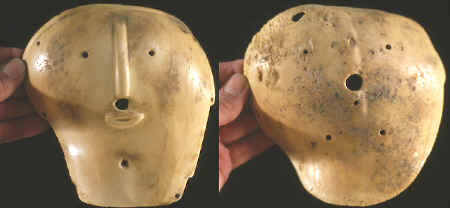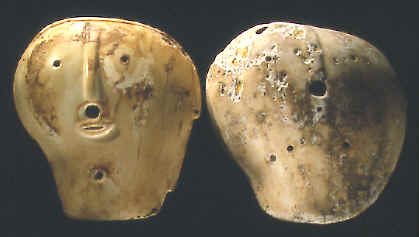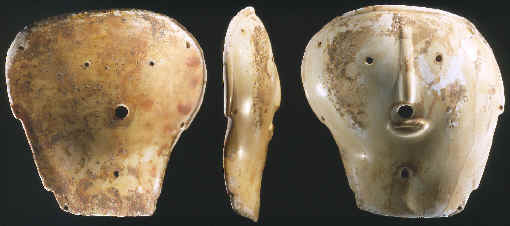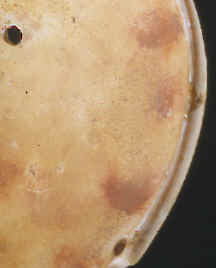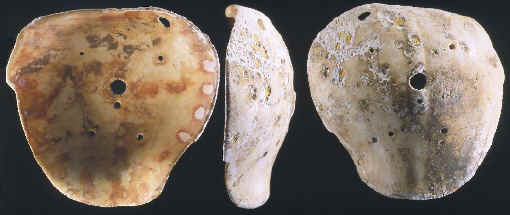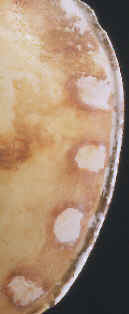|
|
|
In the fall of 1992 two Canadian campers discovered two rare marine shell mask gorgets in a small damp cave in Montana. This cave is located in rugged terrain and on public lands. The two campers reported their find on the National Geographic Hotline soon after the discovery. National Geographic then reported it to the Montana State Historic Preservation Office who in turn contacted the Bureau of Land Management. Native American groups were also contacted and consulted before and after the official recovery of the artifacts began. Representatives from at least two of these agencies accompanied the discoverers back to the find site. |
|
|
|
|
Although rare, the majority of all shell masks have been found in the east and southeastern U.S. in the states of Tennessee, Arkansas, Kentucky, Ohio, Illinois, Iowa, West Virginia, Alabama and Georgia. The two masks from Montana are the most westerly reported finds and they are the only ones ever found in Montana. Manitoba is the farthest north that shell masks have be reported. So they are very widely spread over an area covering thousands of miles. |
|
|
Only one of the shell masks from Montana is carved with a full and obvious facial design. That one has a long narrow nose and two perforated eyes that are similar to the two shell masks from South Dakota. This mask also has a mouth with lips carved in relief. A feature that is unique to both of the Montana masks is the single large hole in their center. It's a design that is unknown on masks from the southeast. Both masks also have many more holes drilled in them than the South Dakota masks and that's also a feature not seen on most shell masks from the southeast. The mask with the face has a total of nine drilled holes and the plain mask has six holes. |
|
|
|
|
Both of the Montana masks were heavily stained with red ochre on their inside surfaces. The pigment was applied in a similar way on both of them. Red patches were "painted" along the inside edges with what appears to have been the persons finger tips. Dr. Tom Roll of Montana State University took samples of the red ochre for carbon dating after suggesting that it may contain an organic carrier suitable for testing. Dr. Marvin Rowe of Texas A&M also took samples of the ochre. At the time of printing one reliable date had been retrieved from a shell sample taken by Dr. Rowe placing it somewhere between 1411 and 1481 A.D. |
|
|
The other shell mask from Montana is in poorer condition and has fewer facial features. It seems to have been the intention of the maker to design a more stylized version of a face. Like the other three masks from South Dakota and the other one from Montana this one also has a long narrow nose that is carved in relief and two perforated eyes. There is also a notched step design carved on the edge that forms a wider area on the upper half where the ears and hair would be and a narrower area at the bottom where the chin would be. |
|
|
|
|
The cave where the Montana masks were found is believed to have been an important spiritual site for northern Plains groups. The fact that the walls were partially smeared with red ochre, the discovery of two shell mask gorgets, the absence of stone debitage or complete projectile points are good indicators that strongly suggest that the Montana masks may have been spirit offerings left there by one of the Plains tribes. In the case of the South Dakota masks, one of them was found on Bear Butte which is considered to be a sacred location by many Plains groups. The other mask was also found on a significant landmark. Local Lakota beliefs indicate that the South Dakota shell masks may have been used in curing ceremonies. |
|
|
|
|
Nothing has been found that would indicate that any of the shell masks from either Montana or South Dakota were associated with a grave. Plans for further investigation of the Montana site was objected to by the Native American tribal representatives and no further excavations are planned. |
|
|
"REFERENCES"
1912,
Frederic Webb Hodge, "Handbook of American Indians North of
Mexico," pp.539-541. |
|
